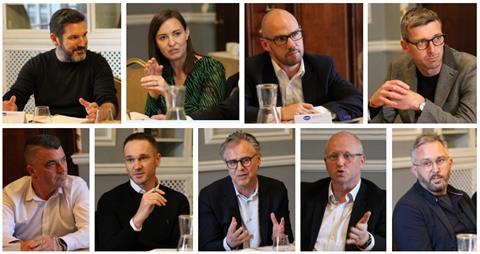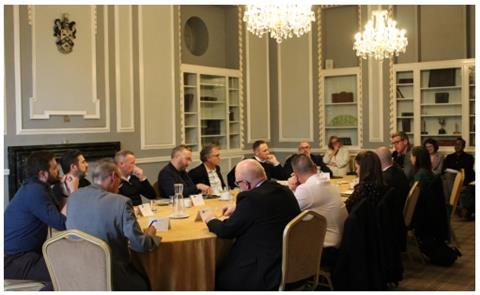Specification decisions have acquired new complexity in the era of the ��ɫ����TV Safety Act. At a roundtable convened by ��ɫ����TV in partnership with Equitone, industry professionals from diverse fields shared their insights on the new challenges and opportunities
The ��ɫ����TV Safety Act has ushered in a transformative era for the construction industry, imposing stringent new requirements and fundamentally altering the landscape of building design and construction, particularly for higher-risk buildings.
In order to explore the critical role of specification decisions in this new context, ��ɫ����TV, in partnership with Equitone, convened a roundtable of professionals from architecture, engineering, construction and client sectors earlier this summer.
The discussion, which took place prior to the publication of the Grenfell Inquiry report, delved into the complexities of balancing aesthetics, functionality and compliance with the new safety regulations, as participants shared their insights into the challenges and opportunities that the new requirements pose.

Challenges and solutions
The roundtable began with an acknowledgment of the profound changes brought by the ��ɫ����TV Safety Act. “We don’t underestimate the challenges,” said Francesca Roberts of architect Hawkins\Brown. “It’s a huge change for everyone involved.”
Alan Morrissey of RLB agreed, highlighting the benefits of the change. “It’s an opportunity to unlearn and relearn, to change things, and to respond to the new gateway requirements with a fresh mindset,” he said.

While conceding this could be a challenge, he emphasised the necessity of embracing these changes as opportunities to enhance control over design processes and ensure compliance from the outset.
Richard Dowdall from Civic Engineers expressed concern about the risk of overspecification at Gateway 2, which could lead to inefficiencies and increased costs. “We have to be cautious about overspecification that can work against us,” he noted.
Roberts also stressed the need for maintaining control over design to ensure compliance and quality. “There are mechanisms in place to manage roles better, and it’s crucial to defend our position to ensure that what is designed is what gets built,” she said.
The role of specification in higher-risk buildings
The need for balance between aesthetics, functionality and stringent safety regulations was a recurring theme, with Michael Riley from BDP describing the “incredible opportunity for designers to adopt a holistic approach to building design” which is facilitated by a thorough consultation process. He highlighted the need to align processes across the industry to ensure consistency and compliance.
On this point, Mike Lee of Equitone emphasised the importance of collaboration for all stakeholders to ensure compliance begins with specification.
He said: “I am looking forward to seeing how we can improve collaboration across the board. I think manufacturers have an important part to play in the process, particularly by providing upfront product information and third-party certifications.”

Riley agreed, saying there is a need for free access to testing information to inform decision-making. “Rigorous and freely available testing information is critical to our decision-making processes,” he said.
Nenad Manasijevic of TP Bennett pointed out that bottlenecks can arise from varying levels of specification and delivery. “Embrace the challenges but be aware of the negative potential of bottlenecks that can add costs at various stages,” he advised.
Graham Kelly of Okana discussed the role of the Construction (Design and Management) Regulations and building regulation advisory services in developing robust back-end systems to track compliance with the ��ɫ����TV Safety Act’s Gateway 2 process. “We need to start tracking regulations to identify potential delays and what needs to be addressed,” he said.
Early engagement and collaboration
There was a consensus around the table on the need to engage the entire supply chain as early as possible, to help mitigate risks.
Gary Farnhill of Longworth ��ɫ����TV Services underscored the importance of early engagement in the project lifecycle. “How early we need to engage is critical,” he said, emphasising that early involvement of all stakeholders can streamline processes and prevent costly changes later.
This sentiment was echoed by much of the panel, with David Kelly from Aecom noting that clients’ understanding of the individual roles across the wider project team would lead to a more collaborative approach and more defined project outcomes, while Ian Aldous of Mace highlighted the inconsistencies that can arise if safety is not prioritised throughout a project.
Tom Kearsley of Glencar added: “Main contractor risk is significant, and having procedures in place early means we are all working together more effectively.” He stressed the importance of pre-construction service agreements (PCSAs) in fostering collaboration and shared responsibility.
This was also important from a design front, with Neal Allen-Burt from Sheppard Robson emphasising the importance of PCSAs in co-ordinating design efforts. “PCSAs are critical for ensuring design co-ordination and managing risks effectively,” he said.
On this point, Civic Engineers’s Dowdall agreed, highlighting the need for early engagement with the supply chain, saying that it is “essential to manage costs and ensure the right specifications are met”.
Lee Smith of Longworth ��ɫ����TV Services agreed on this, saying it was important for all the links in the chain to understand what is required of them in order to ensure compliance and that design requirements are met.

While all agreed that early engagement is key, there were also a consensus that the biggest obstacle to this is financial. Kearsley encapsultated this, pointing out that it is necessary to consider the effect of funding pressures. “Funding pressures can impact collaboration – but having the right team in place can mitigate these issues,” he said.
Cost and resource management
Riley brought up the importance of robust documentation and the implications of Gateway 2 for project timelines. “Getting approvals back from Gateway 2 with robust documentation is essential, and it does require a more rigorous approach,” he explained.
Farnhill spoke about the impact of Gateway 2 on cost management. “We have to consider the cost implications of the materials we choose, especially concerning fire performance and other safety criteria,” he said.
“There is often a misconception about when detailed design should be completed, leading to delays and additional costs,” said Allen-Burt, pointing out that there needs to be a clearer understanding across the industry.
Kearsley emphasised the need for adaptability, saying: “Flexibility is key; as long as the products can achieve the necessary standards, we need to be adaptable. Flexibility and adaptability are key to managing the changes brought by the ��ɫ����TV Safety Act.”
Dowdall raised concerns about resource constraints. “With the new regulations, we might see a significant impact on costs and resource allocation, which needs to be managed carefully,” he said.
Training and upskilling
Hawkins\Brown’s Roberts stressed the importance of training in response to the new regulations. “Training and upskilling are crucial to ensure everyone involved understands their roles and responsibilities under the new regulations,” she said. Kearsley spoke about the importance of having the right skills and knowledge. “Skills, knowledge and experience are crucial. If someone doesn’t have the necessary skills, it can lead to significant issues,” he warned.
Morrissey added that the industry needs to look at itself and adapt. “We need a new mindset and maximum efficiency as dutyholders. The industry must adapt and align with the new requirements quickly,” he said.
Those assembled highlighted the need for there to be increased education for all those in the project team, from the client down, with Lee expressing concern about how clients can determine competence. “How does a client know if a contractor is competent under the new regulations? There needs to be alignment and clear benchmarks,” he said.

Roberts emphasised the importance of good communication with clients. “Communicating clearly with clients about product choices and compliance is crucial for managing expectations and ensuring successful outcomes,” she said.
Graham Kelly highlighted the importance of client collaboration in achieving successful outcomes, saying: “A collaborative approach with clients leads to better-defined projects and fewer changes down the line.”
David Kelly emphasised the importance of regulation-tracking and evidence-matching. “By tracking regulations and ensuring we have the necessary evidence, we can better manage higher-risk buildings,” he said.
Future outlook and adaptation
The panel turned their attention to upcoming regulatory developments in this arena, with Aldous emphasising the importance of the Code for Construction Product Information moving forward. “We need to work through the [code] to ensure safety and consistency,” he said.
Riley agreed and stressed the importance of access to detailed information on testing. “Having access to comprehensive testing information is critical for making informed decisions and ensuring compliance,” he said.
Looking forward, Dowdall highlighted the need to keep being adaptable. “Ongoing collaboration and adaptation are essential to successfully navigating the changes brought by the ��ɫ����TV Safety Act,” he said.
On this point, Morrissey said embracing the chance for a step change in practices is imperative: “The ��ɫ����TV Safety Act is an opportunity to reset industry practices and adopt a more collaborative and efficient approach.”
The roundtable concluded with a consensus on the need for early engagement, collaboration and a holistic approach to building design and construction. The participants agreed that while the ��ɫ����TV Safety Act presents significant challenges, it also offers an opportunity to improve processes, enhance safety and foster a more collaborative industry.
As Graham Kelly succinctly put it, “The challenges are real, but so are the opportunities. By working together and embracing change, we can build a safer and more resilient future.”
The discussion highlighted the multifaceted challenges and opportunities presented by the ��ɫ����TV Safety Act. Through collaboration and early engagement, alongside a focus on compliance and safety, the industry can navigate these changes effectively, ensuring the successful delivery of higher-risk building projects.
Around the table:
- Chair: Jordan Marshall, special projects editor, ��ɫ����TV
- Ian Aldous, director, Mace
- Neal Allen-Burt, partner, Sheppard Robson
- Richard Dowdall, regional director, Civic Engineers
- Gary Farnhill, business development manager, Longworth ��ɫ����TV Services
- Tom Kearsley, operations director, Glencar Construction
- David Kelly, associate director, Aecom
- Graham Kelly, managing director, Okana
- Mike Lee, specification manager, Equitone
- Nenad Manasijevic, principal director, TP Bennett
- Alan Morrissey, specification consultant, RLB
- Michael Riley, architect director, BDP
- Francesca Roberts, senior architect, Hawkins\Brown
- Lee Smith, contracts director, Longworth ��ɫ����TV Services

























